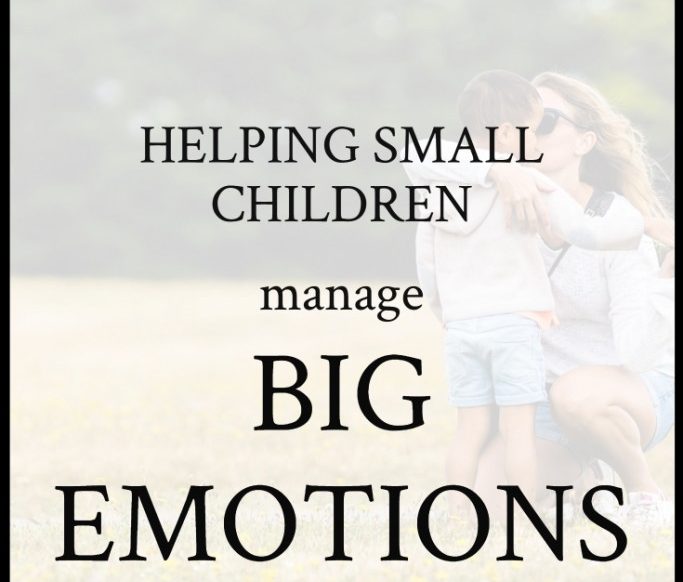As far as I can remember, I was not a highly emotional child. (Maybe I was and just forgot what it was like.) But when I had children of my own, I was in for a bit of a surprise! I had one child in particular whose big emotions were a regular part of our family life.
She would erupt into screams at the drop of a hat. And as the saying goes, she would drop the hat.
If she even imagined that she stubbed her toe, she would cry as loudly as if she’d broken it.
If her brother was being mean to her, she could deliver quite an intimidating speech.
If she was disappointed, there would be weeping and wailing.
I was rather surprised by all this drama, and for a long time I didn’t know how to handle it. My knee-jerk reaction was to tell her that she needed to stop overreacting. But my efforts to stop the emotional outbursts in their tracks almost always made her cry all the harder.
I'm not a perfect parent, but I've at least learned since then that shutting someone's emotions down is not wise.
Below are some of the ways I've attempted to help my children
- Use their feelings as information
- Learn strategies to calm themselves
- Learn to respond appropriately to how they're feeling
I came up with three different aspects that go into helping my children mange their big emotions.

1. First, I've learned to view their big emotions with a compassionate heart and a curious mind.
Children's big emotions can be driven by many, many factors, such as hunger, tiredness, frustration, or simply from feeling the intensity of navigating a confusing world while their brains and bodies are rapidly developing.
We as adults can find ourselves experiencing unpleasant feelings that seem to have no logical origin. We can feel a nagging sense of worry, or we can feel a bit weepy, or we can feel crabby. Most adults know better than to push those feelings outward onto others. We know that to be snappy with others would not be right even though our bodies might feel grumpy. We'd be socially embarrassed to let tears start flowing in front of everyone when there's not really a logical reason to cry. But that doesn't change the fact the fact that we do feel those emotions. And the reasons behind those are often the same reasons behind what are children are feeling in their bodies too – hunger, tiredness, hormonal shifts, or simply the intensity of navigating the daily stresses of the world.
Sometimes the things we feel do overpower us, and we do find the tears flowing over nothing in particular. We do find ourselves being short with others when our bodies are tense with stress. We are more likely to have compassion on ourselves at these times, though, because we understand where those behaviors are coming from. We recognize our hormonal cycles and know that even though there's not a “reason” to cry, the hormonal changes are reason enough. We should apologize when we've spoken to others out of our grouchiness, but we also know that the issue was more about the weakness of our body than it was intentional wickedness.
Helping a child with their big emotions is no different. To tell them to stop overreacting is to discount all the tiny, real feelings that have built up inside their body. When our child's emotions start spilling over onto the people around them, a compassionate hug will go a lot further to calm them than a stern word.
As Christian parents, the fruit of the spirit should be spilling over from us onto our children. Are we showing them the gentleness of the Holy Spirit?
2. Proactively teach children how to respond to what they're feeling.
When a child is already upset, they will not be able to engage the rational, thinking part of their brain. The heat of the moment is not the time to teach my children how to respond when their siblings are rude or when they didn't get the biggest helping of dessert.
Some of the emotions I've tried to proactively teach my children how to handle are
- anger
- disappointment
- frustration
So for example, we can have a conversation like this, “If someone does something you don't like, what can you do? Should you scream at them? Or can you ask them nicely to stop? And if they don't stop, what can you do? Can you come ask mommy to help you?”
We can teach our children how to use words rather than screaming or hitting when they're feeling angry or frustrated. Then in the moment, when their big feelings rise to the surface, we can remind them of what they've already learned.
3. Teach children additional calming techniques.
Help them take deep breaths to calm themselves when they're upset. Teach them how to leave an upsetting situation rather than engaging with it. Teach them how to be in tune with their physical needs like food, water, and sleep, which will greatly impact how they're feeling emotionally.
All of these things take consistent practice and teaching, and that is why the gentleness and compassion mentioned in point number one are so important. Compassion does not excuse our children's bad behavior, but it does investigate whether there are underlying needs that have gone unnoticed (blood sugar, hydration, sleep, emotional connection, getting away from overstimulation.)
Children need to understand that emotions are normal and that they haven’t done anything wrong by having those feelings. But they also need to be taught what to do with those emotions.
As parents, we need a lot of wisdom to know how to help our children with their big feelings. Thankfully, God promises that he will provide it (James 1:5).
Here are some resources that have helped me as a parent to understand a little more about my children's big emotions:
affiliate links below
1. The Highly Sensitive Child: Helping Our Children Thrive When the World Overwhelms Them
2. Beyond Behaviors: Using Brain Science and Compassion to Understand and Solve Children's Behavioral Challenges
3. 10 Mindful Minutes: Giving Our Children — and Ourselves — the Social and Emotional Skills to Reduce Stress and Anxiety for Happier, Healthier Lives
(These books are not written from a Christian perspective, but I have learned many things from them about the way the brain works that allow me to be a more understanding and gracious parent.)













